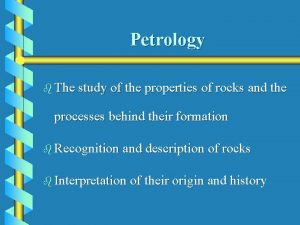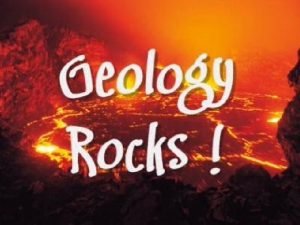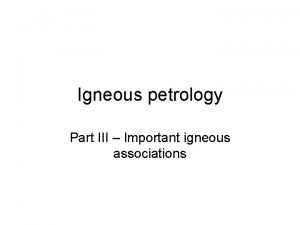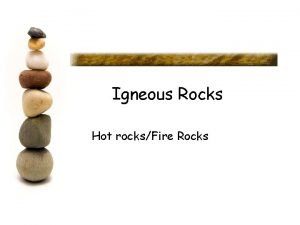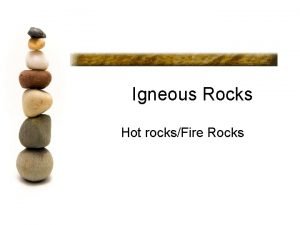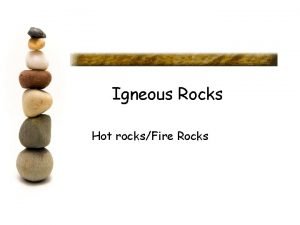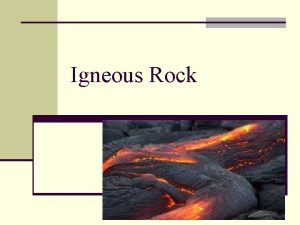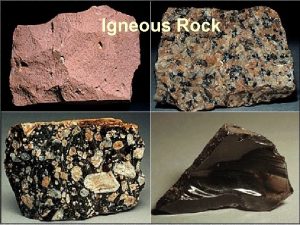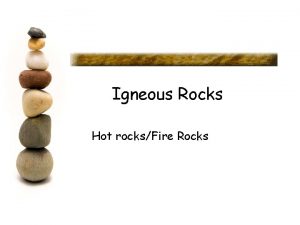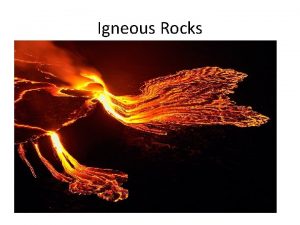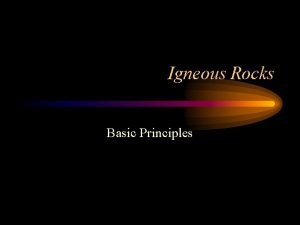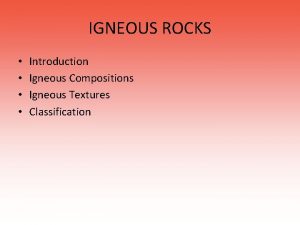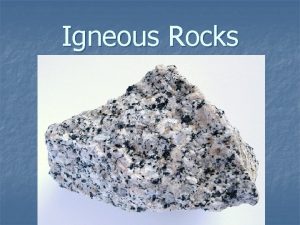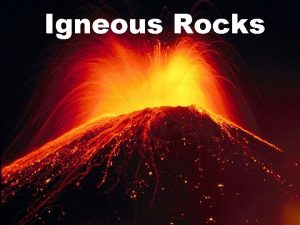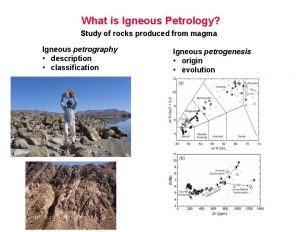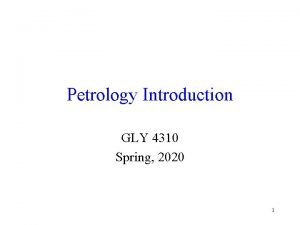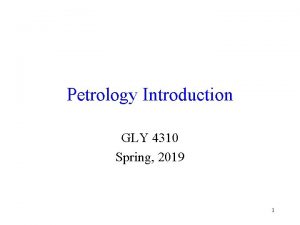Igneous Petrology Geology 12 Petrology is the study








































- Slides: 40

Igneous Petrology Geology 12

• Petrology is the study of rocks and their formation. A rock is simply one or more minerals attached in some manner; it is usually a mixture. • According the principles of uniformitarianism, the geologic processes now at work were also active in the past, and the physical features of the earth were formed from these processes over long periods of time. From this, we can surmise that the rocks we see around us were also formed in the past by the same geological processes we see around us today.

• There are three broad classes of rock: • Igneous rock – formed when molten magma or lava cools • Sedimentary rock – formed either from eroded sediment (mud, sand, gravel, etc) that is deposited and cemented together into new rock, or forms by precipitating out of solution. • Metamorphic rock – formed when a rock experiences intense heat and pressure, altering the rock’s mineralogy and characteristics.


Igneous Rocks • Melting and Crystallization • The Igneous Family includes a wide range of rocks that can form either inside the planet or on the surface. However, at some point all igneous rocks were in a molten (melted) form. If the liquid rock is underground, it is called magma. If the liquid rock is found at the surface, it is called lava. • In this section of the course we will study the processes of how magma forms and how it cools and crystallizes into different types of rocks. Igneous rocks compose more than 50% of the Earth’s crust.

Origin and Crystallization of Magma • There is a lot of heat in the interior of the Earth. Some of this heat comes from the formation of the Earth. Some of it is also from radioactive decay of certain elements, such as Uranium and Thorium. The interior of the Earth is up to several thousand degrees Celsius. At these temperatures, most elements and compounds are above their melting point. The immense pressure in this setting, however, keeps the mantle from being a ‘true’ liquid.

Origin and Crystallization of Magma • When weaknesses (cracks, faults, etc. ) in the crust allow this material to get closer to the surface, the pressure becomes less extreme, and the material can change into a liquid form. This material is technically called melt, but is more commonly called magma.

Origin and Crystallization of Magma

Origin and Crystallization of Magma • As the material migrates upwards heat energy is lost to the surrounding rock (country rock). As the temperature drops, in atoms will slow down and begin to interact with each other. They can react and form new compounds. These compounds will be nuclei for new mineral crystals to grow.

Origin and Crystallization of Magma • Not all minerals form at the same time since each one has a unique melting/freezing point. There is an order to the process, called the Bowen’s Reaction Series. The basic principle is that certain minerals crystallize out of the melt first, and then react with the remaining melt, forming new and/or altered minerals, until all the magma is crystallized.

Plutonic vs. Volcanic Rocks • The major division for igneous rocks is based on rate of cooling. Plutonic rocks or intrusive rocks cool slowly within the earth. They produce relatively large and interlocking crystals. • Volcanic rocks or extrusive rocks form when lava cools on the Earth’s surface. They cool rapidly and the crystals that form are relatively small.

Plutonic vs. Volcanic Rocks • Once it has been determined whether the rock is plutonic or volcanic, the name given is on the basis of colour and mineralogy. • Magmas that form dark coloured minerals form dark coloured rocks. • Magmas that form light coloured minerals form light coloured rocks.

Plutonic vs. Volcanic Rocks • Plutonic and volcanic rocks have different names. They are classified by their percentage of ferromagnesian minerals. Dark minerals typically contain more iron and magnesium.

Terminology • Mafic: • Magma that is rich in iron-magnesium (less Si) • Forms minerals that are (generally) darker in color • Magma/Lava has low viscosity (low silica = ‘runnier’) • Resulting rock is poor in quartz, rich in ferromagnesian minerals

Terminology • Felsic: • Magma that is silica-rich (less Fe and Mg) • Forms minerals that are (generally) lighter in color • Magma/Lava has high viscosity (silica = ‘stickier’) • Resulting rock is rich in quartz and feldspar

Textural Terminology • Grain Size: • Size of individual mineral crystals (fine vs. coarse) • depends on cooling history/conditions • Aphanitic: • When mineral crystals are very small (‘fine’) • magma cooled quickly = little time to form • Phaneritic: • When mineral crystals are large (‘coarse’) • magma cooled slowly = lots of time to form/grow

Textural Terminology • Glassy: • When no crystals are present • magma cooled very fast = no time for growth • Vesicular: • When ‘bubbles’ are present in a rock • gas bubbles were trapped during cooling


Classification • Igneous rocks are generally classified by the chemistry and where they form. These manifests through the mineral composition (what’s in it) and crystal size (where it formed).

Chemical Classification • a sliding scale, using the terms described earlier: Felsic Intermediate Mafic High Silica content Low Silica content Light colored minerals Dark colored minerals

Physical Classification • grain (crystal) size tells you location of formation: Plutonic/Intrusive Large crystal size Formed in the crust Volcanic/Extrusive Small crystal size Formed at/near surface

Names • Once you have described a rock by its color (~mineralogy) and crystal size, you can use a chart to determine specific rock name. Colour of Rock Volcanic Name (finegrained) Very Dark (ultramafic) Plutonic Name (coursegrained) Peridotite Dark (mafic) Basalt Gabbro Medium (intermediate) Andesite Diorite Light (felsic or silicic) Rhyolite Granite

15

Names Plutonic Rock Overall Colour Major Minerals Present Granite Light, few dark minerals Noticeable glassy quartz and light orthoclase (K) or albite (Na) plagioclase feldspars (felsic/ acidic). The few dark minerals are biotite or hornblende. Pegmatite Light, few dark minerals An extremely coarse grained light coloured phaneritic rock, similar composition to granite. Syenite Light, few dark minerals Pink, grey and white orthoclase (K) and plagioclase (Na) feldspars (felsic), and no quartz The few dark minerals are biotite or hornblende.

Names Plutonic Rock Overall Colour Major Minerals Present Quartz Diorite (Tonalite) Medium, similar proportions of light and dark minerals Light minerals, mostly albite (Na) feldspars with some quartz and plagioclase feldspar. Dark minerals are hornblende or biotite. Diorite Medium to dark, more dark minerals Feldspars, mostly grey Ca plagioclase. Dark minerals commonly hornblende, some pyroxene. Gabbro Dark grey to black Mostly dark magnesium and iron minerals, no quartz and some calcium feldspar (mafic). Peridotite Dark Black Mostly pyroxene and olivine with a little calcium plagioclase (ultramafic).

Names Volcanic Rock Rhyolite Dacite Andesite Basalt Overall Colour Light – pale grey, cream Greenish grey, grey Grey, light brown Dark – brown, black Si. O 2 High Viscosity High Medium Med-High Medium Low Med-Low


Other Igneous Rocks • Porphyry is a rock which has both large and small crystals. It has a two stage cooling history: magma started out cooling slowly so large crystals form/grow (called phenocrysts). A sudden change (like an eruption) brings magma closer to or on surface, and the remaining melt cools quickly (into a fine-grained ‘cement’ called groundmass), • Obsidian is very glassy. Although it is usually black in colour, it is usually rhyolitic in composition. Forms from lava with very high water content.

Other Igneous Rocks • Pumice is a low density, frothy, porous, lightcoloured rock formed from gassy rhyolite. • Scoria forms from basalt with a high gas content, creating a very open network of vesicles. It is denser and darker than pumice. • Pyroclastics are broken up angular fragments of igneous volcanic rock. Tuff is a rock formed from volcanic ash less than 4 mm wide. Volcanic breccia is formed from fragments greater than 4 mm wide.

Bowen’s Reaction Series • Norman Bowen found that minerals melt (and solidify) in a particular sequence. • There are three parts to BRS: The discontinuous series (including olivine, pyroxene, amphibole, and biotite); the continuous plagioclase feldspar series; and the residual phases (including quartz, muscovite, and potassium feldspar).

Bowen’s Reaction Series

Continuous Series • right side of Bowen’s Reaction Series • Ca+2 and Na+ can switch places in the mineral plagioclase feldspar. • At high temperatures plagioclase only has Ca, while at low temperatures, plagioclase only has Na. • In between, these ions mix in a continues series from 100% Ca and 0% Na at the high end of the series to 50% Ca and 50% Na at the middle temperatures to 0%Ca and 100% Na at the lowest temperatures. • During this continuous reaction, the early formed plagioclase crystals react continuously with the melt to become enriched in silica and sodium and depleted in calcium.

Continuous Series

Discontinuous Series • On the left side of the reaction series are a group of mafic (or iron-magnesium-rich) minerals olivine, pyroxene, amphibole and biotite • In igneous magmas, if there is enough silica in the melt, each mineral will change to the next mineral lower in the series as the temperature drops. • For example, olivine is the first mineral to form. When the temperature is low enough, all of the olivine will react with the melt to form pyroxene.

Discontinuous Series • As the temperature drops, all the pyroxene will react with the melt to form amphibole; if it continues to drop, all the amphibole will react with the melt to form biotite. • If these minerals react to form other minerals, then how do we find these mafic minerals at the Earth’s surface? • All of these reactions rely on the melt containing enough silica. If there is not enough silica, the reactions will not occur. Minerals further down the series will only form if there is sufficient silica in the melt. Silica is the limiting reagent.

Discontinuous Series

Residual Phases • At the bottom of BRS are the felsic minerals of quartz, muscovite, and potassium feldspar. • These minerals have abundant aluminum and potassium, and higher amounts of silica than the mafic minerals earlier in the series. In fact, quartz is 100% silica.

Residual Phases

Not every magma goes through all steps in Bowen’s series • Silica is needed for the reaction to keep going. If you are crystallizing olivine and there is not enough silica to form pyroxene, then the reaction will not occur and olivine will remain. • A mafic magma (rich in iron and magnesium) will completely crystallize before it reaches the lower temperature stages of the discontinuous reaction. • A silicic magma is rich in silica and poor in magnesium and iron. So, olivine and pyroxene will be reabsorbed and will be absent from the resulting rock. • If you are crystallizing a mineral and the temperature drops rapidly, then the BRS will stop at that point, and further reactions will not occur.

 Petrology is the study of
Petrology is the study of Xvfk
Xvfk Từ ngữ thể hiện lòng nhân hậu
Từ ngữ thể hiện lòng nhân hậu Trời xanh đây là của chúng ta thể thơ
Trời xanh đây là của chúng ta thể thơ Tư thế ngồi viết
Tư thế ngồi viết Gấu đi như thế nào
Gấu đi như thế nào Thế nào là giọng cùng tên
Thế nào là giọng cùng tên Thể thơ truyền thống
Thể thơ truyền thống Hươu thường đẻ mỗi lứa mấy con
Hươu thường đẻ mỗi lứa mấy con đại từ thay thế
đại từ thay thế Thế nào là hệ số cao nhất
Thế nào là hệ số cao nhất Diễn thế sinh thái là
Diễn thế sinh thái là Vẽ hình chiếu vuông góc của vật thể sau
Vẽ hình chiếu vuông góc của vật thể sau Ng-html
Ng-html 101012 bằng
101012 bằng Thế nào là mạng điện lắp đặt kiểu nổi
Thế nào là mạng điện lắp đặt kiểu nổi Mật thư tọa độ 5x5
Mật thư tọa độ 5x5 Lời thề hippocrates
Lời thề hippocrates Vẽ hình chiếu đứng bằng cạnh của vật thể
Vẽ hình chiếu đứng bằng cạnh của vật thể Chụp phim tư thế worms-breton
Chụp phim tư thế worms-breton Quá trình desamine hóa có thể tạo ra
Quá trình desamine hóa có thể tạo ra Khi nào hổ mẹ dạy hổ con săn mồi
Khi nào hổ mẹ dạy hổ con săn mồi Dot
Dot Các châu lục và đại dương trên thế giới
Các châu lục và đại dương trên thế giới Thế nào là sự mỏi cơ
Thế nào là sự mỏi cơ Bổ thể
Bổ thể Phản ứng thế ankan
Phản ứng thế ankan Thiếu nhi thế giới liên hoan
Thiếu nhi thế giới liên hoan Tia chieu sa te
Tia chieu sa te Chúa sống lại
Chúa sống lại điện thế nghỉ
điện thế nghỉ Một số thể thơ truyền thống
Một số thể thơ truyền thống Sơ đồ cơ thể người
Sơ đồ cơ thể người Công thức tiính động năng
Công thức tiính động năng Thế nào là số nguyên tố
Thế nào là số nguyên tố Tỉ lệ cơ thể trẻ em
Tỉ lệ cơ thể trẻ em đặc điểm cơ thể của người tối cổ
đặc điểm cơ thể của người tối cổ Các châu lục và đại dương trên thế giới
Các châu lục và đại dương trên thế giới ưu thế lai là gì
ưu thế lai là gì Thẻ vin
Thẻ vin Các môn thể thao bắt đầu bằng tiếng đua
Các môn thể thao bắt đầu bằng tiếng đua
